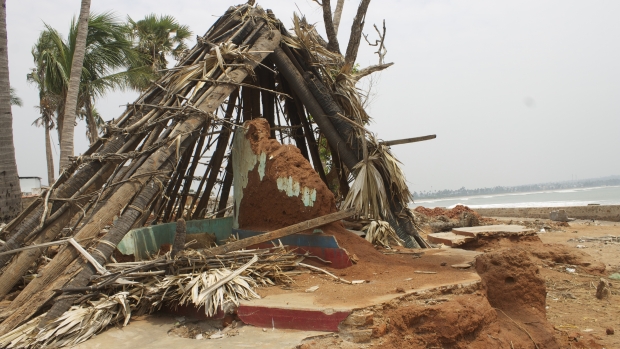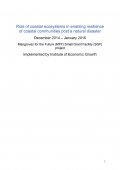Grants :: Small Grant Facilities :: Role of coastal ecosystems in enabling resilience of coastal communities post a natural disaster
Role of coastal ecosystems in enabling resilience of coastal communities post a natural disaster

Significant parts of the Andhra Pradesh were destroyed due t ... , Andhra Pradesh © Nisha Maria D'Souza, 2015
Objectives
The project addressed intended to accomplish the following objectives
- To assess the impacts of Hudhud on coastal ecosystems and local livelihood in selected coastal villages in Andhra Pradesh
- To examine the differential impacts of natural calamity like cyclones on vulnerable groups includinglike women, children, and the elderlyold people, etc.
- To develop cyclone impact models to measure the potential impacts of cyclones on selected villages.
- To examine the coastal protection services of coastal vegetationcoastal bio-shields present in areas affected by cyclones Phailin and Hudhud.
- To recommendsuggest resilience building measures
Background
Building resilience to climate extremes and disasters is a necessary requirement to ensure the success of global efforts to eliminate extreme poverty, the first of the Sustainable Development Goals (SDGs). The eEast coast of India witnesses frequent cyclonic disturbances, and severe fresh water flooding and has some of the highly most densely populated areas inof the country, particularly, in the deltaic plains of the Mahanadi, the Godavari, the Krishna and the Cauvery rivers where more than 400 people live per sq km area. This combination of frequenttoo many disasters and high populationtoo many people requires that ‘resilience building to disasters’ is taken up as an urgent necessity for attaining primary SDGs. Coastal ecosystems (like mangroves and sand dunes) provide various ecosystem services that include protection from storms, as well as livelihood support to coastal communities.
In October 2013, cyclone Phailin, categorized as 5 on the Saffir-Simpson scale, and Extremely Severeon the Indian Meteorological Department scale, made landfall in Golaphur town, on the Odisha coast. It prompted India’s largest scale evacuation, and more than 12 million people were affected. In October 2014, another tropical cyclone, Hudhud, classified as Category 4, and Extremely Severe, made landfall near the coastal city of Visakhapatnam, in Andhra Pradesh. The Andhra Pradesh Government estimated damages to be within the vicinity of USD 3.4 billion.
The Areas impactedaffected by cyclones Phailin and Hudhud are endowed with natural ecosystems like wide Casuarina plantations, Palmyra palms, sand dunes, and other green plantation belts includinglike cashew plantations, mixed forests, and coconut grooves etc. There is limited information on the role that these ecosystems have played in influencing or mitigating the impacts of the cyclones on human habitations, and the role they are now playing in supporting local communities’ livelihoods. Some ecosystems may provide better protection from storms and may provide little livelihood support and the reverse may be true for some other vegetation types. Casuarina trees have been the prime candidate for shelterbelt plantations along Indian coast and there are concerns that the promotion of such bioshields, which are mostly exotics, as coastal buffers may lead to inappropriate coastal development in some places (Feagin et al. 2010a, 2010b). Recent studies also shownproved that Casuarina to have either aggravatesd damage occurrences or have providesd little to no protection from disasters, as compared withto the native vegetation speciess at different places during the super cyclone of October 1999 in Odisha, India (Das and Sindhu, 2014). Other than mangroves and Casuarina, there is little study on theother types of vegetation, especially cashew and palmyra palms which are the dominant species inat some of the coastal areas, with regard to the ecosystem services like coastal protection, livelihood support, etc they provide and how they compare with the Casuarina trees. Areas impacted by cyclones Hudhud and Phailin affected areas of coastal India provided a good opportunity to study such services of different types of vegetation and provide recommendationssuggestions regarding the best coastal buffers to policy and decision makers addressingdealing with coastal management
Target beneficiaries
Coastal managers; decision-makers; natural resource managers
Outputs
The results of this study clearly indicate that there are several long-term measures that can be undertaken to build the resilience of coastal communities to natural disasters, and ensure that their financial status is not detrimental to their coping capabilities. It is recommended that steps are taken to raise the awareness and capacities of coastal communities to access opportunities and benefits of insurance policies and schemes, and in smart asset investment and financial saving plans in order that they are better self-prepared for the impacts of disasters. It if further advised that coastal managers take steps to strengthen protection along the coastline through the development of large (in terms of width and length) native multi-species plantations, and conservation of existing coastal vegetation and natural infrastructure. Moreover, measures should be taken to build concrete homes for all coastal communities, particularly in areas known to be susceptible to frequent high intensity natural disasters.
Accomplishments and challenges
The following were identified as some of the losses due to Cyclone Hudhud
- All groups suffered loss during Hudhud, however both farmers and fishermen suffered the highest, the loss being larger than their average annual income. Salt producers and manual labourers suffered minimum loss indicating that assets based occupations caused more loss and damage.
- Nearly 37 percent of the households practiced subsidiary occupations, casual labour being the most commonly practiced one amongst the sample households. Around 64 percent of households were headed by males and 36 percent headed by females. Comparing the income and loss figures of these households, one finds women headed households to be earning less and to have suffered less in monetary terms as well. This may indicate women headed households to be more resilient by not investing in risky assets.
- All farmers included in the sample, except two, suffered agricultural loss. ThisIt included loss of main crops, especially like rice, vegetables like brinjal, papaya, chilies, onion, drumsticks, and other horticulture crops like coconut, banana, and ground nuts etc. The main cause was strong wind that either broke or up-rooted the trees and saline inundation. Multiple crop loss and land quality loss due to saline inundation are the reasons for the farming community suffering the maximum.
- Nearly 38 percent of households had kuchha or mud structured houses, 33.5 percent pucca or concrete houses and 28.5 percent has semi-pucca houses. 71 percent of the sample households suffered house damage meaning even some concrete house owners had suffered some damage to their houses. Of these 71 percent, house of 48 percent got were fully damaged, another 48 percent got were partially damaged and rest 4 percent were washed away.
- Fishermen suffered both direct and indirect losses. Direct losses included loss of boats, nets, engines and other fishing materials, and loss of fishing days. The indirect losses whereas the lower catch rates after the cyclone, i.e. that drastically reduced the sizes and quantities of catch. Whereas prior to Hudhud only 13 fishermen used to get 10kg or less of fish per trip. before Hudhud, following after Following the storm, 141 fishermen reported to have been getting such this amount per trip. Fishermen reporting/getting 11 to 15 kg per trip also increased after Hudhud and for higher catch sizes, number of fishermen getting such catch decreased after Hudhud. However, these data figures related to only inshore fishery, not off shore fishery.
- Other than agricultural, house and fishery loss, some 82 percent of the households reported to have lost work days because of the cyclone. Work days lost varied from less than 10 days to more than two months. Maximum seemed to have lost 21 to 30 days of work in the period immediately after Hudhud.
Contributions to cross-cutting themes
More than 100 million live in low-lying coastal regions of Asia and are under persistent risk from the impacts of disasters including those less visible, like sea level rise, and those more extreme and dramatic like cyclones and storm surges. The linkages between poverty, disasters and climate extremes are being increasingly discussed and studied as the vulnerabilities of communities have increased in recent years owing to various factors including rapid population growth, which has forced ever more people to live in marginal, hazard-prone regions such as low lying urban areas, disaster prone coastal areas, and flood plains. Other factors include the degradation and loss of natural ecosystems , which act as the first line of defense against natural disasters.
Lessons Learned
The study faced the only challenge in conducting the household survey, especially in eliciting appropriate response from households. Engagement of more experienced and social science based surveyors should be engaged in future.
Project Facts
Country
Location
Andhra Pradesh
Topic
Duration
15th Dec 2014 to 15th Jan 2016
MFF Grant Amount
INR 1,017,500
Co-financing Partner
IEG - INR 120,000
Implementing Partner
Dr. Saudamini Das
Associate Professor, Institute of Economic Growth
Related Publications

Role of coastal ecosystems in enabling resilience of coastal communities post a natural disaster
Author: IEG and IUCN
Publisher: IUCN
Posted on: 12th May 2016
Category: SGF (Small Grant Facility)
Size: 796 KB